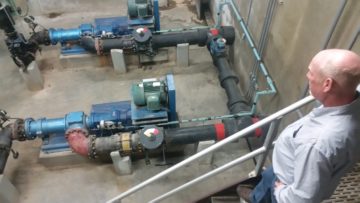By JAN LARSON McLAUGHLIN
BG Independent News
Doug Clark takes it personally when people complain about the foul smells coming from the wastewater plant on the east side of Bowling Green.
As superintendent of the Water Pollution Control Plant on Dunbridge Road, Clark is intensely proud of the violation-free operation that treated 2.2 billion gallons of wastewater and stormwater last year. He takes pride in the fact that nearly every step in the treatment is done with biological processes, not chemicals.
Improvements at the plant have resulted in a 50 percent reduction in the total solids left from the process – creating a product the EPA has approved for sale to a local landscaper who blends the solids with topsoil and sand. None of the solids are applied to farm fields anymore.
The finished liquid product looks like crystal clear water and meets EPA standards as it is sent down Poe Ditch to the Portage River.
But there’s one thing that Clark gets prickly about – complaints about the stench from the plant.
“It’s pretty amazing,” Clark said as he held up a cup of the clear finished liquid product that was the result of the very complex biological process at the plant. “We get it right a lot more than wrong. Yet the only thing we’re known for is odors every once in awhile.”

Clark concedes that the odors are particularly pungent on some days, especially when the wind is coming from the north, sending the smell toward businesses along Dunbridge Road.
“Typically, it’s wet heavy mornings when it’s most noticeable,” he said. “It’s those days when you smell it, it’s really bad. There’s no way to know if it’s going to be one of those days.”
Though Clark said the staff at the plant does get accustomed to the smells, some days “we do notice it.”
The wastewater plant has made several attempts to sweeten the smells emitted. It uses an aerobic digestion process with bacteria that helps consume the waste.
“Our job is to provide the best environment for the bacteria to absorb it,” Clark said.
“We have done a lot of work” to reduce the odors since Clark took over as superintendent in 2007.
To lower the ammonia content, the wastewater is run through filters layered with large rocks, then smaller porous rocks, then root material. That process gets rid of some odors, but “quite frankly, not the most offensive ones.”
“We have done just about everything we can,” Clark said.
Just about.
But now Clark and Brian O’Connell, director of public utilities for the city, want to try one more fix. The two recently visited the wastewater plant in Harrisburg, Pennsylvania, which uses activated carbon to take out all the remaining odors that aren’t stopped by the aerobic digestion process.
“It’s the belts and suspenders part of the equipment that takes care of the odors that get through the biofilter,” O’Connell said. “We’re hopeful it will benefit us the same way.”
The price tag to get rid of the annoying smells – $220,000.
The money is not in this year’s wastewater treatment budget, but O’Connell said he is looking for other projects that could possibly be put on hold, or funds that could be diverted from other projects.
As the city eyes costly improvements to spruce up the East Wooster corridor and the entrance to the city from Interstate 75, some have questioned if the odors from the wastewater plant wafting over area will detract from the investment.
Clark is aware that strong sewer odors on some days are more detrimental than others, like the recent weekend of soccer tournaments due south of the plant.
“There’s a lot of pressure,” he said. “I take this personally.”
“We do the best we can,” Clark said, adding that the process is at the mercy of the biological process.
Clark and O’Connell are quick to point out that the wastewater plant operates very efficiently, which has saved the city “tens of millions” of dollars by treating sewer and stormwater effectively rather than requiring the city to separate its sewers.
The plant takes in an average of 5.5 million gallons a day, but on heavy rain days it can handle close to 10 million gallons a day.
“I hate rain,” Clark said…..almost as much as he hates the smells he is trying to eliminate.

